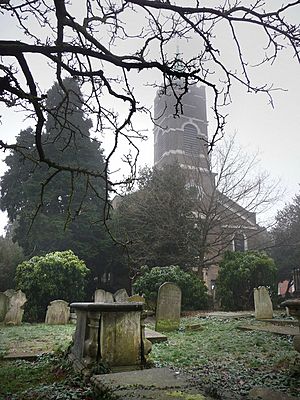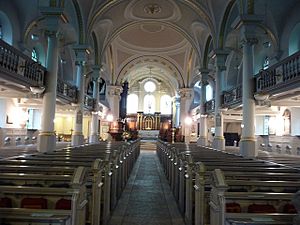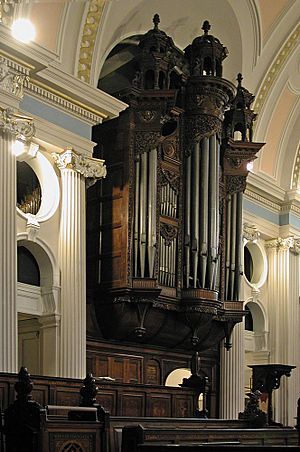St John-at-Hampstead facts for kids
Quick facts for kids St John-at-Hampstead |
|
|---|---|
| Parish Church of St. John the Evangelist, Hampstead | |

St John-at-Hampstead
|
|
| 51°33′19″N 00°10′53″W / 51.55528°N 0.18139°W | |
| Location | Church Row, Hampstead, London NW3 |
| Country | United Kingdom |
| Denomination | Church of England |
| Churchmanship | Broad Church/Liberal Anglo-Catholic |
| Website | hampsteadparishchurch.org.uk |
| History | |
| Dedication | St John the Evangelist |
| Architecture | |
| Heritage designation | Grade I listed |
| Designated | 11 August 1950 |
| Architect(s) | Henry Flitcroft John Sanderson Robert Hesketh F. P. Cockerell Temple Moore |
| Style | Classical |
| Completed | 1747 |
| Administration | |
| Parish | Hampstead |
| Diocese | Diocese of London |
St John-at-Hampstead is a Church of England church located in Church Row, Hampstead, London. It is dedicated to St John the Evangelist. The church is a very old building with a rich history. It is also a Grade I listed building, which means it is considered very important and protected.
Contents
History of St John-at-Hampstead
The land where the church stands was given to Westminster Abbey monks in 986. It's likely they built a church there soon after. The first official records of a church date back to 1312. At that time, it was mentioned that John de Neuport was its priest. In 1333, there was also a mention of a small chapel dedicated to the Virgin Mary.
When Henry VIII closed the monasteries, the church became part of the Bishop of Westminster's control. The first church building was made partly of stone and partly of wood. It also had a small wooden tower.
Building a New Church
As Hampstead became a popular health resort, the old church became too small and run-down. By 1744, it was declared unusable. A new church was built based on designs by Henry Flitcroft and John Sanderson. It was officially opened on October 8, 1747.
However, by 1827, this new church was also too small. Plans to make it bigger were first rejected because they were too expensive. Finally, in 1843, plans by Robert Hesketh were approved. These plans extended the church by 30 feet to the west. This added 524 more seats for people.
Changes and Improvements
In 1853, the church got its first Willis organ. This organ was built by Henry Willis, who also worked as the church's organist. The organ was later replaced in 1883 and repaired in 1997.
In 1871, there were plans to "beautify and improve" the church. These plans included taking down the tower. But famous artists and writers like William Morris, Edward Burne-Jones, and Anthony Trollope protested. So, the tower was saved. Instead, the church was extended again in 1877–78. These extensions were designed by F.P. Cockerell. They moved the church's main altar to the west end, which is unusual for churches.
Later, in 1911–12, the church's vestries (rooms for clergy) were improved by Temple Moore. He also added a Morning Chapel. In 1958, the dark Victorian-era paint was removed. The church's original lighter, whitewashed look was brought back.
Music at St John-at-Hampstead
The church has a long and strong tradition of music. This tradition goes back to the time of Henry Willis. Under the leadership of Martindale Sidwell, the church became known for its excellent parish music. Today, it still has a professional choir and a junior choir. They also hold many high-profile concerts.
The Organ
Records show that organs have been in the church since the mid-1700s. The organ used today was installed by Henry Willis in 1884. It has been restored and rebuilt twice. First by Harrison and Harrison in 1964, and then by Bower and Co in 2000. You can find details about the organ on the National Pipe Organ Register and the church's website.
Past Organists
Many talented musicians have served as organists at St John-at-Hampstead. Here are some of them:
- Samuel Reay (1854–56)
- James Shaw (1874-95)
- George Aitken (1894–1942)
- Martindale Sidwell (1947–92)
- Simon Lawford (1993–94)
- Lee Ward (1994–2012)
- James Sherlock (2012–2017)
- Peter Foggitt (2018–2021)
- Geoffrey Webber (2021–present)
Churchyard and Notable Burials
The churchyard of St John-at-Hampstead is a special place. Many famous people are buried there. These individuals made important contributions in different fields.
Here are some of the notable people buried in the churchyard:
- Eliza Acton, a well-known food writer.
- Herbert Beerbohm Tree, a famous actor and theatre manager.
- John Constable, a celebrated romantic painter.
- Peter Cook, a popular writer and comedian.
- Henry Cort, an inventor who worked with iron.
- Eleanor Farjeon, a beloved author.
- Hugh Gaitskell, a leader of the Labour Party.
- John Harrison, the inventor of the marine chronometer.
- Kay Kendall, an actress and film star from the 1950s.
- E.V. Knox, a poet and editor of Punch magazine.
- Mary Knox, who illustrated the Mary Poppins stories.
- Arthur Llewelyn Davies and his wife Sylvia Llewelyn Davies. Their children inspired J M Barrie's Peter Pan.
- George du Maurier, an author and cartoonist.
- Gerald du Maurier, an actor and manager, father of novelist Daphne du Maurier.
- Temple Moore, the architect who worked on the church.
- Nicholas Parsons, a well-known actor and TV presenter.
- Richard Norman Shaw, another important architect.
- Evelyn Underhill, an Anglo-Catholic writer.
- Anton Walbrook, an Austrian actor.
- Alec Waugh, a writer.
The churchyard also contains 8 war graves. These include 6 servicemen from World War I and 2 from World War II.
Images for kids




